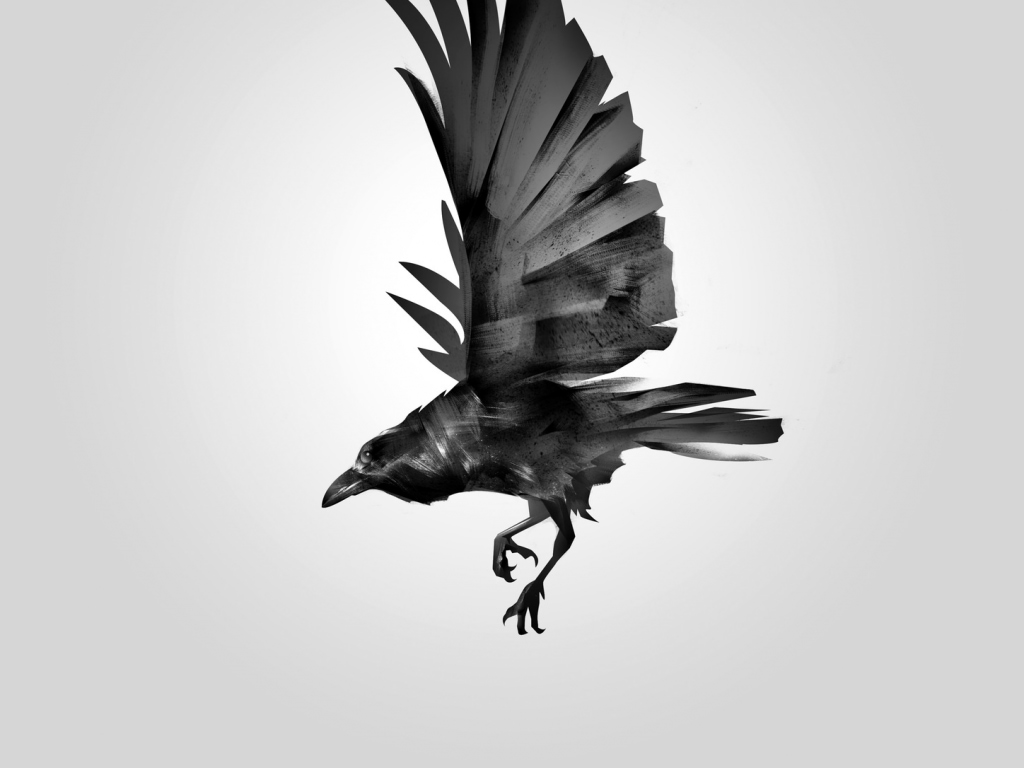In Japan, the public perception of crows got off to a pretty good start: According to the Kojiki and the Nihonshoki, two of Japan’s oldest written records, a gigantic crow known as the Yatagarasu guided the mythical first emperor of Japan to the part of the country now known as Nara. This crow, which is often depicted with three legs, can be found at the Kumano shrines of Japan, and even more commonly, on the uniforms of the Samurai Blue – Japan’s national soccer team.
But even though they have been common figures in art from well before the Edo period, crows are generally seen with a mixed perspective in Japan. On one hand, you have the traditional song “Yuyake Koyake,” which plays on loudspeakers every afternoon and whose lyrics tell us return home like the crows return to their roosts in the trees, but there are also still the associations of the birds with death – even today, there is a superstition that if a crow perches on a house at night and calls out, someone in that house will die before long. We may be happy to return home like crows – as straight as they fly – but we don’t necessarily want them roosting with us.
“The Tokyo Metropolitan Government receives some 600 calls a year from Tokyoites who’ve been attacked by crows”
Today, perhaps, the biggest problem that people face with crows around Tokyo is trying to keep them out of their garbage. And the birds can cause other kinds of trouble as well: the Tokyo Metropolitan Government receives some 600 calls a year from Tokyoites who’ve been attacked by crows – most often in spring, around the time when the birds are hatching their eggs and raising their newborn young.
Nonetheless, crows have their fans in Tokyo, just as they do everywhere around the world. Why? It could be their intelligence – crows know how to use tools, they recognize human faces, and they’ve even been observed to hold what look to be funerals. It might be their distinctive voices: crows and their larger cousin the ravens are believed to possess some of the most complicated vocabulary of calls of any bird. Or maybe it’s a shared sense
of play. The birds have been seen using wind currents like children might use waterslides, throwing paper to themselves, going body surfing on snowy banks, and playing with balls.
It was probably a combination of these traits, as well as their sheer number, that drew a filmmaking couple, Kris Samuelson and John Haptas, to devote a few years to the crows of Tokyo. They got their first exposure to the birds when they were returning from teaching in Southeast Asia and stopped for a while in Tokyo. As they explained, “there was a garden where we were staying and we were amazed by the huge number of crows we heard and saw. We were intrigued and began noticing them everywhere we went.”
Samuelson and Haptas returned home to Northern California, intent on learning more about city crows – “the urban guerrillas of birds,” the couple calls them – in general, and about Tokyo’s crows in particular. A short visit to Japan to shoot a funding clip followed, and a year and a half later, the couple received a Japan-US Creative Arts Fellowship that allowed them to spend five months in Japan shooting what would become Tokyo Waka.
In the words of the filmmakers, the documentary is “an essay about man and nature coexisting in a megalopolis.” Its subjects include scientists, nature lovers, artists, a homeless woman, Shinto and Buddhist priests, and, of course, Corvus macrorhynchos: the jungle crow, also known as the large-billed crow. We see them building nests with hangers stolen from people’s balconies, chased away by the bees that make the honey that is sold through the Ginza Bee Project, and at play in the city’s many parks. The film has its darker moments – we see a crow that has been trapped by the Tokyo Metropolitan Government and bagged for euthanization, for example – but these scenes all help to draw a fuller picture of the interaction between humans and the animals they share the city with.
“It’s a complicated beast for Tokyo: it is inadvertently ‘raised’ on what we throw away, but we really can’t control it”
As one of the film’s subjects states, “Japan has a love of nature, but it’s a kind of nature that is moderated by mankind – not necessarily a ‘wild’ nature.” And that’s why the crow is a complicated beast for Tokyo: it is inadvertently “raised” on what we throw away, but we really can’t control it, despite our best efforts.
Another figure who is equally fascinated by the city’s crows is Hajime Matsubara, an Affiliate Associate at Tokyo University’s Intermediatheque. His first early exposure to the birds set him on the course of research that has become part of his life’s work: “One day in my childhood, I heard a flock of crows cawing to each other, on the way to their roost. It looked as if they were talking, so I tried to call them, imitating their call. A few seconds later, two or three crows ‘replied.’ Of course, I’m not sure that they really called back or were calling to each other for their own purposes. Anyway, that was an impressive experience for me.”
To this day, he remains impressed by their attitudes, which he often likens to those of humans, and their “limitless ability to adapt to any environment.” And despite the city’s best efforts to control the crow population, he believes that crows have done quite well in the city. Matsubara estimates that the crow population in Tokyo is somewhere between 18,000 (the official estimate of the Tokyo Metropolitan Government) and 100,000.
As Tokyo Waka explains, trapping and gassing crows has been the official city policy for keeping the crow population down, but Matsubara doesn’t believe this is the best long-term approach (and not just because the crows are getting wiser to the city’s traps). “I think garbage control is the most successful way. Because, if their food resource is decreased, their reproductive success and survival rate must decrease. If we continue piling up garbage bags on the street and keep carrying capacity high, nothing can stop the crows from breeding and coming into Tokyo from other places in Japan.”
When asked about their intelligence, he responds cautiously: “That’s a very difficult question, because they are very smart in some aspects and very foolish when it comes to other matters. For example, crows are insightful and capable of long-term planning. Their cousins, the common raven have shown researchers that they can figure out how to untie bow knots simply by watching other individuals’ behavior. But, for example, they don’t recognize their own mirror images, which is something that even pigeons can do.” However, when it comes to feeding, and figuring out how to stay fed alongside human beings, he thinks that crows are geniuses: “In Tokyo, [when it comes to feeding strategies] crows can adapt to human behavior very quickly – sometimes within some minutes.”
“The crow has an outside perspective, and sees right through our beauty and our ugliness”
Perhaps one of the things that attracts us to crows is that they give us a seemingly limitless opportunity to interpret their behavior. For example, even though Matsubara watches his research subjects with a scientist’s eye, he says that he’s noticed two things that humans can learn from the resourceful crow: “‘Make the most of every opportunity and be careful in seeking them out’” and ‘Love is forever.’ Why? Because crows eat everything – even if it is garbage. And crow pairs seldom separate.”
And, after all, who’s to say that the crows aren’t considering us, as we go about our days? Akiyoshi Taniguchi, a Buddhist priest at Chohouin Temple in Kuramae, who was interviewed for Tokyo Waka – and who had a prize goldfish taken from the temple pond by a crow – strikes a philosophical note as he muses about how the crows of Tokyo might look at the two-legged creatures they share the city with: “They are observing us in their own way. The crow has an outside perspective, and sees right through our beauty and our ugliness.”
For more information about Tokyo Waka, visit www.stylofilms.com/tokyowaka.html. To learn more about the Intermediatheque, visit www.intermediatheque.jp/en









